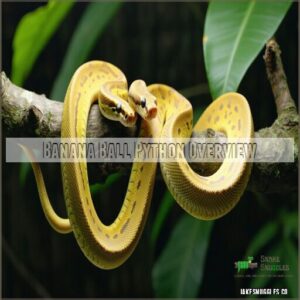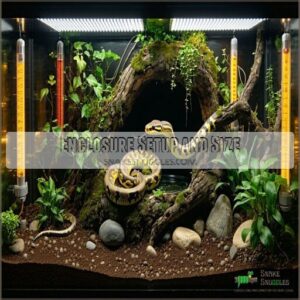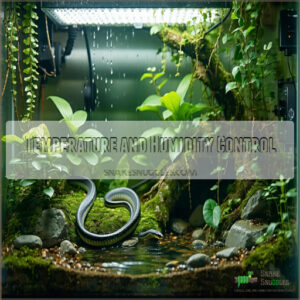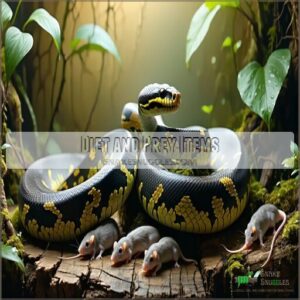This site is supported by our readers. We may earn a commission, at no cost to you, if you purchase through links.
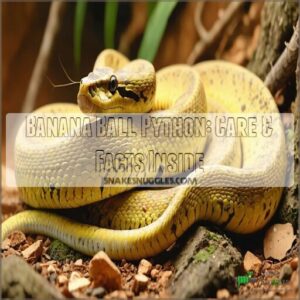 You’ll love the banana ball python for its striking yellow color and easygoing nature.
You’ll love the banana ball python for its striking yellow color and easygoing nature.
These West African natives get their name from their banana-like patterns and make excellent pets.
They typically reach 3-4 feet long and have a gentle temperament that’s perfect for beginners.
Your banana ball python will thrive in a proper enclosure with controlled temperature and humidity.
They’re not picky eaters and usually accept frozen-thawed rodents without fuss.
Watch for the fascinating way their colors change as they age – just like a ripening banana.
Their care needs are straightforward but getting the details right makes all the difference, ensuring your pet stays healthy with a proper enclosure and controlled temperature.
Table Of Contents
- Key Takeaways
- Banana Ball Python Overview
- Genetics and Breeding Patterns
- Housing and Habitat Requirements
- Care and Feeding Requirements
- Health and Potential Issues
- Frequently Asked Questions (FAQs)
- Are banana ball pythons rare?
- What makes a banana morph ball in python?
- What is the difference between banana pastel and banana ball python?
- Are banana ball pythons endangered?
- Is banana ball python rare?
- Are banana ball pythons friendly?
- What does the banana gene do in ball pythons?
- Do banana ball pythons have venom?
- Are banana ball pythons suitable for beginners?
- How often do banana ball pythons shed?
- Conclusion
Key Takeaways
- You’ll find banana ball pythons are ideal beginner pets, reaching 3-4 feet in length with a gentle temperament that makes handling easy and safe – they’re non-venomous constrictors that rarely show aggression.
- Your snake needs an enclosure of at least 120 gallons as an adult, with temperatures between 75-95°F and proper humidity levels, plus multiple hiding spots to feel secure and regulate their body temperature.
- You’ll need to feed adult banana ball pythons every 10-14 days with frozen-thawed rodents, while hatchlings require more frequent feeding every 5-7 days to support their growth.
- You can identify banana ball pythons by their distinctive yellow or yellowish-orange coloration with light gray patterns, and they’ll develop unique dark brown freckles as they age – though once rare, they’re now readily available from breeders at prices between $129-$429.
Banana Ball Python Overview
You’re about to learn about the Banana Ball Python. It’s a popular pet snake with a unique appearance and interesting facts.
Scientific Name and Classification
You’re exploring the Banana Ball Python.
Its scientific name is Python regius, a species classification within the Pythonidae family, specifically the Python genus.
This biological nomenclature reflects its genetic coding, identifying it as a ball python, with the Banana Ball Python being a distinct morph.
Origin and Habitat
Banana Ball Pythons hail from West Africa, where they’ve become quite the sensation.
These snakes are native to a range of habitats, from savannas and grasslands to sparsely wooded areas.
While they can climb trees, they usually keep their feet on solid ground.
Here are some key points about their natural habitat:
- Savannas Habitat: Banana Ball Pythons feel right at home in the vast savannas of West Africa, where they can find plenty of cover and prey.
- Grassland Ecosystem: They’re also adapted to life in grassland ecosystems, where they can easily blend in with their surroundings.
- Tree Climbing: Although they’re not big fans of climbing, these snakes can scale trees if they need to.
- Native Range: West Africa is their native range, and they’re particularly fond of the countries of Mali and the Central African Republic.
- West African Snakes: In their natural habitat, Banana Ball Pythons stand out from other West African snakes with their vibrant yellow and tan coloration.
Understanding their natural habitat needs is essential for their survival and well-being.
Physical Appearance and Morphs
You’ll notice the banana ball python’s unique color patterns, with base tones of yellow and blotch shapes resembling an ageing banana.
This morph type features a distinct scale texture, making the banana ball python appearance stand out, showcasing its beautiful banana ball python coloration and various morphs like banana pastel ball python.
The banana ball python requires proper ball python care to thrive in captivity.
Genetics and Breeding Patterns
You’re about to learn how genetics play a role in breeding Banana Ball Pythons. You’ll discover how sex chromosomes and inheritance patterns affect the breeding process.
Sex Chromosomes and Inheritance
You’re learning about ball python genetics.
- Genetic Mutations
- Sex Determination
- Chromosome Linkage
- Inheritance Patterns
Gene Expression impact banana ball python morphs, like banana x enchi and banana x pastel, through complex python genetics.
Understanding ball python genetic traits is essential for breeders to produce desired morphs.
Female and Male Makers
You’ll find male bananas can be female-makers or male-makers, influencing the sex ratio of offspring.
Understanding maker genetics is key to breeding banana ball pythons.
Female makers produce equal male and female ratios, while male makers produce mostly females or males, depending on their genetics.
Breeding Methods and Challenges
Breeding banana ball pythons presents unique challenges.
Understanding codominant traits and morph inheritance is key.
Genetic mutations influence the banana ball python morph.
- Consider the banana x albino ball python combination.
- Research ball python banana genetics.
- Learn about banana ball python breeding techniques.
- Understand sex ratio manipulation in banana ball python breeding.
Note the generally docile banana ball python temperament.
Housing and Habitat Requirements
You’ll need to set up a suitable enclosure for your banana ball python. You should consider the snake’s size and provide a spacious habitat with proper temperature and humidity control.
Enclosure Setup and Size
You’ll need a tank size that adapts to your banana ball python’s growth.
A 15-20 gallon tank is suitable for hatchlings, while adults require at least 120 gallons.
Choose enclosure materials wisely for humidity control and ventilation systems to create a suitable banana ball python enclosure.
Determining the best python tank size is essential for creating a healthy environment, considering factors related to python tank specifications, which involves understanding the importance of a suitable python tank.
Temperature and Humidity Control
I’ll control temperature and humidity for your banana ball python.
Heat sources and thermostat settings create a temperature gradient.
Maintaining proper humidity levels is critical for snake health.
Maintain humidity levels with ventilation systems.
Aim for 75° to 95° temperatures and proper humidity for a healthy banana ball python environment, ensuring a suitable temperature gradient and humidity levels.
Substrate and Hiding Places
For your snake’s comfort and health, focus on the substrate and hiding spots in their enclosure.
First, choose an absorbent substrate like cypress mulch to maintain humidity. Second, provide hide boxes for thermoregulation and a sense of security.
Third, maintain a temperature gradient of 75° to 85°F. Fourth, keep the snake enclosure clean and replace the substrate regularly.
Care and Feeding Requirements
You’ll need to provide a balanced diet for your banana ball python. You should research diet and feeding requirements to keep your snake healthy.
Diet and Prey Items
You’ll feed your banana ball python prey items like rodents.
Fancy rats are a common food source.
Understanding their feeding habits and nutritional needs is key to a healthy diet, mirroring their natural hunting strategies with appropriate food sources.
Providing the right frozen rat supplies is essential for their care.
Feeding Schedule and Frequency
Now that you know what to feed your banana ball python, let’s talk about how often they need to eat.
You don’t want to overdo it, but you also don’t want to leave them hungry. Here’s a simple guide to their feeding frequency:
- Hatchlings (0-12 months): These little ones have big appetites. Feed them every 5-7 days.
- Adults: They’re less hungry and more laid-back. Offer food every 10-14 days.
- Adjust for Individual Snakes: Keep an eye on your snake’s body condition. Adjust feeding times as needed. Understanding a proper snake feeding schedule is essential for their health and growth.
Water Requirements and Hydration
You maintain your banana ball python’s water quality by changing drinking bowls daily.
Maintain proper humidity levels and moisture control for effective hydration methods, providing fresh water to prevent dehydration, a key aspect of snake hydration and banana ball python care, with proper humidity being crucial.
Health and Potential Issues
You’ll want to monitor your banana ball python’s health closely. You should watch for signs of common issues like snake mites, mouth rot, and respiratory infections.
Common Diseases and Parasites
Your banana ball python’s health needs regular monitoring.
Watch for respiratory issues with signs like wheezing or nasal discharge.
Snake mites appear as tiny black dots and cause excessive soaking.
Mouth rot shows as inflammation around the mouth.
Internal parasites often cause weight loss despite normal eating.
Regular cleaning prevents many infections.
Most snake diseases require prompt veterinary treatment for successful recovery, and this often involves addressing issues like respiratory issues.
Handling and Stress Management
Three simple rules make handling your banana ball python stress-free.
First, support their entire body when lifting them. You’ll want to avoid quick movements that might startle them.
Second, wash your hands before and after handling to prevent disease transfer.
Shedding and Skin Problems
The ball python’s shedding process offers a window into their health. You’ll notice color dulling and milky blue eyes about a week before shedding starts.
Here’s what to watch for:
- Wrinkled skin appearance during pre-shed phase
- Reduced activity and appetite throughout process
- Complete shed should come off in one piece
- Discharge or pustules may signal skin infection
- Proper humidity prevents problematic sheds
A healthy shed cycle occurs every 4-6 weeks with visible skin changes. Keep temperatures at 80-85°F and avoid handling during this time. Understanding snake shedding problems is important for maintaining your ball python’s overall well-being and health.
Frequently Asked Questions (FAQs)
Are banana ball pythons rare?
Like finding a four-leaf clover, these snakes were once rare treasures. Today you’ll find them readily available from breeders. They’re priced between $129-$429, making them accessible for most snake enthusiasts.
What makes a banana morph ball in python?
You’ll notice distinctive yellow or yellowish-orange backgrounds with light cool gray patterns.
The morph comes from a genetic mutation that creates tan base colors and vibrant yellow patches with dark brown freckles.
What is the difference between banana pastel and banana ball python?
Banana pastel combines two morphs with brighter backgrounds and bolder patterns. You’ll notice more intense coloration and blushed-out head than regular banana balls, which display primarily yellow and pink hues.
Are banana ball pythons endangered?
These popular pet snakes aren’t endangered, but they’re classified as "Near Threatened" by the IUCN.
Their wild populations are decreasing due to the pet trade, poaching, and habitat loss.
You’ll mostly find captive-bred specimens.
Is banana ball python rare?
Once commanding prices over $1,000, these striking serpents aren’t rare anymore. You’ll find them readily available from breeders today, though certain unique color combinations can still be quite scarce.
Are banana ball pythons friendly?
You’ll find these snakes exceptionally docile and easy-going in nature.
They’re great pets for beginners since they rarely show aggressive behavior.
With proper handling and care, they’ll remain calm and gentle.
What does the banana gene do in ball pythons?
The gene creates yellow or yellowish-orange coloring instead of the usual brown base.
You’ll notice lighter patterns ranging from cool gray to pale mauve with small black speckles developing as they age.
Do banana ball pythons have venom?
Like a gentle kitten in snake form, you’ve got nothing to worry about.
They’re harmless constrictors that don’t have any venom.
You’ll find them using their muscles rather than toxins to catch prey, and this behavior is a key aspect of their nature, making them harmless.
Are banana ball pythons suitable for beginners?
You’ll find them ideal for your first snake.
They’re docile, easy to handle and maintain.
Your care routine won’t be complex.
Just provide proper housing, temperature control and regular feeding schedules.
How often do banana ball pythons shed?
Shedding schedules shift seasonally as your snake grows.
You’ll notice them shed every 4-6 weeks during their first year.
After that, they’ll typically shed every 6-8 weeks depending on growth and health.
Conclusion
Welcoming a banana ball python into your home opens the door to a fascinating world of reptile companionship.
You’ll find these gentle creatures make outstanding pets with their manageable size and easy-care requirements.
Their distinctive yellow patterns and calm demeanor set them apart from other snake species.
With proper housing, steady temperatures, and regular feeding, your banana ball python will thrive for years to come.
Take the plunge – you won’t regret choosing this remarkable serpentine friend.
- https://www.morphmarket.com/morphpedia/ball-pythons/banana/
- https://www.xyzreptiles.com/reptiles/animals/snakes-for-sale/ball-pythons-for-sale/banana-ball-pythons/
- https://imperialreptiles.com/collections/banana-ball-pythons-for-sale
- https://www.worldofballpythons.com/morphs/banana-ball/
- https://www.reddit.com/r/ballpython/comments/ptvslm/are_banana_ball_pythons_issue_free/

